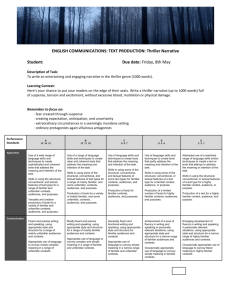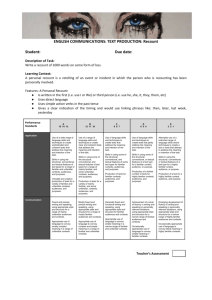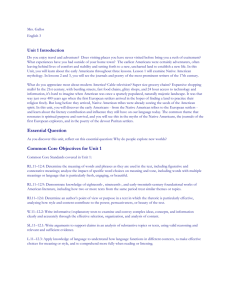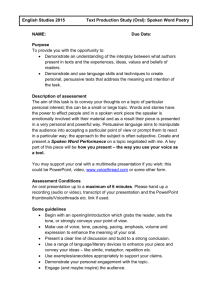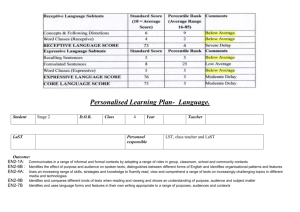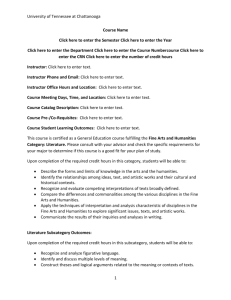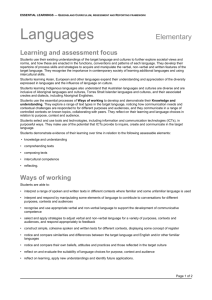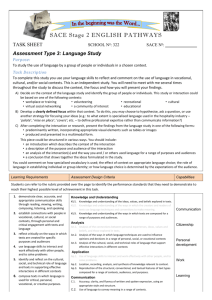Task Sheet with rubric created using SACE criteria
advertisement
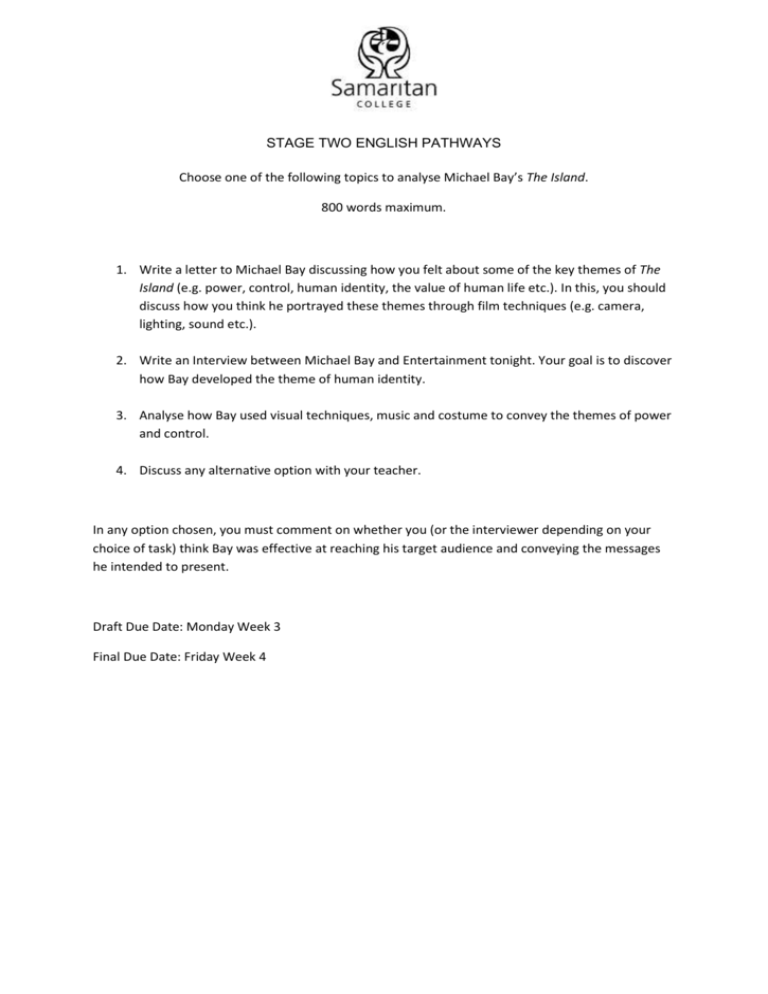
STAGE TWO ENGLISH PATHWAYS Choose one of the following topics to analyse Michael Bay’s The Island. 800 words maximum. 1. Write a letter to Michael Bay discussing how you felt about some of the key themes of The Island (e.g. power, control, human identity, the value of human life etc.). In this, you should discuss how you think he portrayed these themes through film techniques (e.g. camera, lighting, sound etc.). 2. Write an Interview between Michael Bay and Entertainment tonight. Your goal is to discover how Bay developed the theme of human identity. 3. Analyse how Bay used visual techniques, music and costume to convey the themes of power and control. 4. Discuss any alternative option with your teacher. In any option chosen, you must comment on whether you (or the interviewer depending on your choice of task) think Bay was effective at reaching his target audience and conveying the messages he intended to present. Draft Due Date: Monday Week 3 Final Due Date: Friday Week 4 A Knowledge and Understanding Analysis Application Communication Detailed knowledge and understanding of the ideas, values, and beliefs in familiar and unfamiliar texts. Detailed analysis of complex connections between personal experiences, ideas, values, and beliefs, and those explored in familiar and unfamiliar texts. Use of a comprehensive range of language skills to interact effectively in different contexts, and to analyse and solve simple and complex problems. Fluent and precise writing and speaking, using an appropriate style and structure for a range of mainly unfamiliar audiences and contexts. Knowledge and understanding of the ways in which the creators and readers of familiar and unfamiliar texts use a range of language techniques to make meaning. Comprehensive knowledge and understanding of the ways in which familiar and unfamiliar texts are composed for a range of purposes and audiences. B Sound knowledge and understanding of some ideas, values, and beliefs in familiar, and some unfamiliar, texts. Knowledge and understanding of the ways in which the creators and readers of mainly familiar texts use some language techniques to make meaning. Sound knowledge and understanding of the ways in which mainly familiar texts are composed for some purposes and audiences. C Knowledge and understanding of some ideas, values, or beliefs in familiar texts. Knowledge and understanding of the ways in which the creators and readers of a narrow range of familiar texts use some language techniques to make meaning. Knowledge and understanding of the ways in which familiar texts are composed for familiar purposes and audiences. D Identification of some simple ideas, values, or beliefs in some familiar texts. Knowledge and understanding of the ways in which the creators and readers of a narrow range of familiar texts use a restricted range of language techniques to make simple or factual meaning. Knowledge of the ways in which familiar texts are composed for personally relevant purposes and familiar audiences. E Identification of a simple idea, value, or belief in a familiar text. Some knowledge and emerging understanding of the way in which a creator or reader of a highly familiar text uses a language technique to make factual meaning. Some knowledge of the ways in which highly familiar texts are composed for personally relevant purposes and highly familiar audiences. Perceptive analysis of a range of ways in which authors use language techniques to influence opinions and decisions in familiar and unfamiliar texts. Analysis of some complex connections between personal experiences, ideas, values, and beliefs, and those explored in familiar, and some unfamiliar, texts. Well-considered analysis of a range of ways in which authors use language techniques to influence opinions and decisions in familiar, and some unfamiliar, texts. Competent analysis of simple connections between personal experiences, ideas, values, or beliefs, and those explored in familiar texts. Descriptive analysis of a number of ways in which authors use language techniques to influence opinions and decisions in familiar texts. Reference to simple connections between uncomplicated personal experiences, ideas, values, or beliefs, and those explored in familiar texts. Reference to some ways in which authors use language techniques to influence opinions and decisions in familiar texts. Recognition of a simple connection between a straightforward personal experience, idea, value, or belief, and that explored in a highly familiar text. Reference to the way in which an author uses language techniques to influence opinions and decisions in a highly familiar text. Location, recording, analysis, and synthesis of knowledge relevant to familiar and unfamiliar contexts. Sophisticated skills in reproducing the structural, conventional, and textual features of text types for a range of familiar and unfamiliar contexts, audiences, and purposes. Use of a sound range of language skills to interact effectively in different contexts, and to solve simple and complex problems. Location, recording, analysis, and occasional synthesis of knowledge relevant to mostly familiar contexts. Sound skills in reproducing some of the structural, conventional, and textual features of text types for a range of mainly familiar, and some unfamiliar, contexts, audiences, and purposes. Use of competent language skills to interact effectively in different contexts, and to solve routine problems in familiar contexts. Location, recording, and occasional analysis of knowledge relevant to a familiar context. Skills in reproducing some of the structural, conventional, and textual features of some text types for familiar contexts, audiences, and purposes. Use of a restricted range of language skills to interact in familiar contexts, and to solve simple problems. Location and recording of factual knowledge relevant to a familiar context. Limited skills in reproducing some of the structural, conventional, or textual features of a text type for a familiar context, audience, or purpose. Use of a restricted range of language skills to interact in highly familiar contexts, and to solve simple problems. Location or recording of factual knowledge relevant to a highly familiar context. Restricted skills in reproducing a limited number of structural, conventional, or textual features of a text type for a highly familiar context, audience, or purpose. Appropriate use of language to convey mostly complex meaning in a range of familiar and unfamiliar contexts. Mostly fluent and precise writing and speaking, using an appropriate style and structure for a range of mostly familiar audiences and contexts. Appropriate use of language to convey complex and simple meaning in a range of familiar, and some unfamiliar, contexts. Generally clear and accurate writing and speaking, using an appropriate style and structure for familiar audiences and contexts. Appropriate use of language to convey simple meaning in a narrow range of familiar and unfamiliar contexts. A level of fluency in writing and speaking in personally relevant situations, using an appropriate style and structure for a narrow range of familiar audiences and contexts. Occasionally appropriate use of language to convey simple meaning in familiar contexts. Emerging development of fluency in writing and speaking in personally relevant situations, using an appropriate style and structure for a narrow range of highly familiar audiences and contexts. Occasionally appropriate use of language to convey literal meaning in highly familiar contexts.

